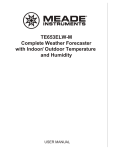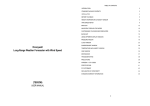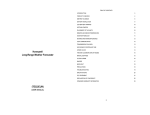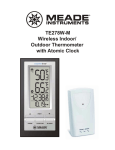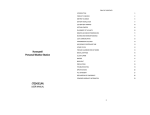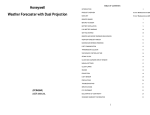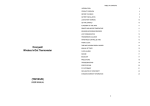Download Meade TS33C-M Specifications
Transcript
TABLE OF CONTENTS INTRODUCTION 3 STANDARD PACKAGE CONTENTS 3 BEFORE YOU BEGIN 4 PRODUCT OVERVIEW 5 REMOTE TEMPERATURE & HUMIDITY SENSOR 5 MAIN UNIT Honeywell Barometric Weather Forecaster 7 WEATHER FORECAST 14 PRESSURE HISTORY CHART 14 MOON PHASE ICONS 15 PRESSURE MODE 15 REMOTE AND INDOOR TEMPERATURE & HUMIDITY 16 AUTO-SCANNING 17 PROGRAMMABLE TEMPERATURE ALARM 17 COMFORT LEVEL INDICATORS 18 MAXIMUM AND MINIMUM READINGS 19 LOST COMMUNICATION 19 TRANSMISSION COLLISION 20 WWVB RADIO CONTROLLED TIME 20 ATOMIC CLOCK 21 TIME AND CALENDAR DISPLAY MODES 22 MANUAL SETTINGS 22 CLOCK ALARMS 23 SNOOZE 24 BACKLIGHT 25 TROUBLESHOOTING 25 PRECAUTIONS 26 (TE653ELW) SPECIFICATIONS 26 USER MANUAL FCC STATEMENT 28 DECLARATION OF CONFORMITY 29 STANDARD WARRANTY INFORMATION 30 2 INTRODUCTION BEFORE YOU BEGIN Thank you for selecting the Honeywell Barometric Weather Forecaster. This device combines precise time keeping with monitoring and displaying the temperature/humidity data from up to three remote locations. • We recommend using alkaline batteries for the remote temperature and humidity sensor and the main unit when temperatures are above 32°F (0°C). We recommend using lithium batteries for the remote sensor when temperatures are below 32°F (0°C) In this package you will find: • One main unit (receiver) TE653ELW • One three-channel remote temperature and humidity sensor (transmitter) TS33C • One User Manual Please keep this manual handy as you use your new item. It contains practical step-by-step instructions, as well as technical specifications and precautions you should know. • Avoid using rechargeable batteries. (Rechargeable batteries cannot maintain correct power requirements) • • ALWAYS install batteries in the remote sensor before the main unit Insert batteries before first use, matching the polarity in the battery compartment • • • Remove protective plastic screen from LCD display (if any) During an initial setup, place the remote sensor close to the main unit After reception is established (all remote readings will appear on the main unit’s display), position the remote sensor and the main unit within the effective transmission range of 100 feet (30 meters).Ideally it should be placed within the line of sight from the main unit. • Transmission/reception range may be affected by trees, metal structures and electronic appliances, by surrounding building materials and the way how the receiver (main unit) and transmitter (remote sensor) are positioned. STANDARD PACKAGE CONTENTS Picture Components Main Unit (receiver) Thermo Hygrometer Sensor (transmitter) • • The main unit must be placed indoors. Place the remote sensor so that it faces the main unit (receiver), minimizing obstructions such as doors, walls and furniture. NOTE: When the temperature falls below freezing, the batteries in the outdoor remote sensor may have reduced voltage supply and a shorter effective range. We recommend using lithium batteries at temperatures of 32°F (0°C) and below. IMPORTANT: Make sure that remote sensor is easily accessible for cleaning 3 3 4 and maintenance. We recommend cleaning the remote sensor periodically, as the dirt and debris may affect sensor accuracy. PRODUCT OVERVIEW REMOTE TEMPERATURE & HUMIDITY SENSOR FEATURES • • • Remote data transmission to the main unit via 433 MHz frequency LCD displays temperature, humidity and channel Selection of the temperature display in Celsius or Fahrenheit • • Three (3) transmission channels selection Case can be wall mounted using built-in hanger A. LED INDICATOR • Flashes once when the remote sensor transmits a reading to the main unit. • Flashes twice when battery power is low. B. BATTERY COMPARTMENT • Holds two AA-size batteries C. RESET • D. CHANNEL SWITCH • Selects the desired channel -1,2 or 3 E. WALL-MOUNT RECESSED OPENING • Keeps the remote sensor on the wall F. °C/°F SWITCH • Selects the temperature display in Fahrenheit or Celsius NOTE: Install the batteries; select the channel and temperature in °C or °F before mounting the sensor. BATTERY INSTALLATION • Remove the screws from the battery compartment with a small Phillips screwdriver. • Set the channel 1 through 3. The switch is located in the battery compartment. Channel 1 is typically selected if only one remote sensor is being used. • Install 2 “AA” size alkaline batteries (not included) matching the polarities shown in the battery compartment. • Select the temperature unit in °F or °C by pressing °C/°F switch with a paper clip or similar tool • Replace the battery compartment door and secure the screws. • Secure the remote sensor in the desired location. MOUNTING • • Use the wall mount hardware and screws when mounting the thermo-hygrometer sensor on the wall PLACEMENT • Resets all previous settings 5 The remote thermo-hygrometer sensor can be placed on the flat surface or mounted on the wall in vertical position The remote thermo-hygrometer sensor should be placed in the area 5 6 with a free air circulation and sheltered from the direct sunlight and an extreme weather conditions. Weather • Weather forecast for the next 12 to 24 hour in five large icons: Sunny, Partly Cloudy, Cloudy, Rainy and Snowy • • • Barometric pressure in imperial or metric units Altitude adjustment for pressure compensation 24 hour barometric pressure history chart • Indoor/Outdoor Temperature & Humidity in up to 3 remote locations (additional sensors required) The international standard for the valid air temperature measurements is 4 feet (1.25meters) above the ground. OPERATION • • Three Remote Channels Auto-Scan feature Minimum and maximum memory for indoor and remote temperature and humidity Immediately after batteries are correctly installed, the remote sensor will start • • • Comfort level indicators Programmable Hi/Low Temperature Alarm Operating range of 100 feet (30 meters) • • Low Battery Indicators Enhanced Blue Backlight • 2 AA batteries (main unit) • 2 AA batteries (remote sensor) FRONT/TOP • Ideally, place the thermo-hygrometer sensor above the natural surfaces (such as a grassy lawn). • Avoid placing the thermo-hygrometer sensor near sources of heat, such as chimneys and heating elements. • Avoid any areas collecting and radiating a heat from the sun, such as metal, brick or concrete structures, paving, patios and decks. • transmitting a temperature and humidity data to the main unit. MAIN UNIT The main unit measures pressure, indoor temperature, humidity, and receives atomic time data from the US Atomic Clock and all remote sensors. It should be placed indoors. FEATURES Time • • Time automatically sets to the US Atomic Clock 12 or 24 hour time format • • Manual adjustment of time and date Day of the week displayed in English, Spanish, French, German and Italian • Moon Phase calendar • • Dual crescendo alarms with programmable snooze Programmable Ice Warning Alarm 7 Power 7 8 • Allows toggling between two different clock modes – time with seconds and time with the day of the week • When depressed and held, activates clock programming mode • Confirms programmed parameters D. ALARM button • Allows toggling between the calendar display and three time alarm modes • When depressed and held, enters into the alarm programming mode for a selected parameter TEMP ALARM button • Allows toggling between high/low limits for temperature alarm and current outdoor temperature reading E. REAR/SIDE • Activates a high/low temperature alarm programming mode F. UP ( ▲) button • • Increases the parameters When depressed and held, activates manual search for atomic time signal • Enables or disables time alarms (W) and (S) and Ice Warning Alarm G. DOWN ( ▼) button • • A. WEATHER AND TIME IN EASY-TO READ DIGITS B. MEM button • Allows displaying current, minimum, maximum readings of the indoor and remote temperature & humidity • When depressed and held, clears collected records memory C. MODE button 9 Decreases the parameters When depressed and held activates manual search for signals from the remote sensors • Enables or disables time alarms (W) and (S) and Ice Warning Alarm H. CHANNEL button • • Recalls a different remote sensor reading – 1,2 or 3 When depressed and held activates the remote channels auto-scan feature I. HISTORY button 9 10 • Allows displaying pressure history records J. SNOOZE/LIGHT button • Stops all alarms temporarily • Activates a backlight for 5 seconds K. Back panel UP (▲) button Increases the parameters of pressure and altitude L. Back panel DOWN (▼) button Decreases the parameters of pressure and altitude M. Back panel UNIT button When depressed and held activates pressure & altitude units programming mode N. Back panel PRESSURE/ALTITUDE button • Allows toggling between SEA LEVEL pressure, LOCAL pressure and ALTITUDE modes • When depressed and held, enters into the altitude programming mode O. BATTERY COMPARTMENT Accommodates 2 (two) UM-3 or AA 1.5V alkaline batteries P. REMOVABLE TABLE STAND Holds unit in upright position on a flat surface Q. WALL- MOUNT RECESSED OPENING Keeps the unit on the wall BATTERY INSTALLATION • • Remove the battery compartment door located on the back. Insert two (2) AA size batteries according to the polarities shown and replace the battery compartment door. • When placing the main unit on the table or other horizontal surface, unfold the table stand adjusting it to the desired viewing angle. 11 • When mounting the main unit on the wall or vertical surface, remove the table stand from the unit. PLACEMENT • Make sure that the main unit is locating within the operating range of the remote sensor • Ideally the remote sensor should be mounted within the line of sight of the main unit. • Transmission range may be affected by trees, metal structures and electronic appliances. • Test reception before permanently mounting the remote sensor Avoid placing the main unit in the following areas: • Direct sunlight and surfaces emitting and radiating heat, such as heating ducts or air conditioners. • Areas with interference from the wireless devices (such as cordless phones, radio headsets, baby listening devices) and electronic appliances. OPERATION The weather forecaster is designed to measure local pressure and calculate the other two parameters based on the Local Pressure. Sea Level Pressure and Altitude are interdependent. If you adjust altitude, it will calculate sea level pressure, if you adjust sea level pressure, it will automatically calculate altitude. You can only adjust one of the two – either sea level barometric pressure or altitude. If you wish to know pressure changes at your specific location (house), the LOCAL barometric pressure should be selected In this case, the local altitude/elevation must be programmed according to GPS readings, Internet, etc. If you wish to know pressure changes in your surrounding metro area, then 11 12 SEA LEVEL barometric pressure option should be selected. In this case, the SEA LEVEL barometric pressure value can be adjusted according to the local metro area weather information. (Sources – local TV or radio station, etc). NOTE: Locate your altitude with a portable GPS receiver or topographical • Press UP or DOWN to adjust an altitude value. Press and hold either button for the advanced setting. • Press PRESSURE/ALTITUDE button to confirm the programmed altitude. map .Locate barometric pressure at: http://weather.noaa.gov/weather/ccus.html or, alternatively, from local radio or TV weather channels. Unit will show dashes “- - - “instead of local barometric pressure for a moment and then will self-adjust to the new altitude Once the main unit is powered, the display will show all available LCD WEATHER FORECAST segments for a moment IMPORTANT: All of the display functions will be locked, allowing setting pressure parameters and your local altitude. The locked display will show the abbreviation “hPa/mBar” flashing in the Pressure Mode, indoor temperature This unit is capable of detecting the atmospheric pressure changes. Based on collected weather data, it forecasts the weather for the next 12 to 24 hours. and humidity readings in Temperature/Humidity Mode, default time in Clock Mode and a default date in the Alarm/Calendar Mode. If the pressure and altitude are not configured during this time, the unit will self-calibrate in a few minutes and show the default settings for the pressure and altitude (sea level) and the remote sensor reading. NOTE: This is the only time when you can enter/adjust your local altitude units and value. To set the pressure & altitude units and program your altitude, use the main unit Note: The weather forecast accuracy is approximately 70%. Display shows forecasted, not current conditions. The SUNNY icon indicates clear weather, even when displayed during the night-time buttons located on the back: • • Press UP or DOWN button on the back of the unit selecting the pressure in inHg or hPa/mBar Press UNIT button to confirm and move to the altitude unit selection mode • Press UP or DOWN button selecting the altitude unit in feet or meters. • Press UNIT button to confirm and move to the altitude value programming mode. 13 PRESSURE HISTORY CHART The pressure bar graph shows barometric pressure variations over the past 24 hours. This is very useful for understanding the Barometric trends that are used in weather forecasting. Each bar icon represents 0.06 inHg or 2mBar 13 14 PROGRAMMING SEA LEVEL PRESSURE • Press PRESSURE/ALTITUDE button on the back until the pressure with “SEA LEVEL” mark is displayed. • Press and hold PRESSURE/ALTITUDE button until the pressure digits are flashing. • Set the sea level pressure by pressing UP or DOWN buttons. Press and hold either button for the quick digits advance. • Press PRESSURE/ALTITUDE button to confirm selection. MOON PHASE ICONS REMOTE AND INDOOR TEMPERATURE & HUMIDITY After batteries are installed; remote sensor will transmit temperature and humidity data at 45 second intervals. The main unit may take up to two minutes PRESSURE MODE The pressure mode indicates the current local barometric pressure, the sea level pressure and a moon phase. It also displays barometric pressure value for the past 36 hours in 1 hour intervals. Pressure can be set in inHG or HPa/mBar and altitude can be set in feet or meters. VIEWING PRESSURE AND ALTITUDE INFORMATION To view a pressure or altitude information, press PRESSURE/ALTITUDE button on the back rotating between the sea level pressure, local pressure and local altitude screens. to receive the initial readings. Upon successful reception, remote temperature and humidity will appear next to the weather forecast section of the main unit’s display (the default remote channel is channel one). The main unit will automatically update readings at 45-second intervals. After communication between the main unit and remote sensor has been established, secure the remote sensor in the desired location. The wave icon is located above the remote channel number indicates the reception status from the corresponding remote sensor. There are three following types of the reception status may be displayed: The unit is in a searching mode. Temperature and humidity readings are securely registered. No signals detected. 15 15 --16 flash • Use UP( ▲) or DOWN(T) arrow buttons to adjust the higher temperature limit • • Press the TEMP ALARM button to confirm the selected value Press the TEMP ALARM button once to enter into the Low Temperature Alarm programming mode – the abbreviation “OF” with the low temperature limit symbol (T) will be displayed on the remote temperature line Press and hold the CHANNEL button for 2 seconds – the icon “3” will appear on the main unit display to the left of the COMFORT LEVEL indicator. All three remote channels data will be displayed one-by-one automatically with 11 seconds delay in the following sequence: Channel 1, Channel 2 and • Press and hold TEMP ALARM button until the abbreviation “OF” will flash • Use UP( ▲) or DOWN(T) arrow buttons to adjust the lower temperature limit Channel 3. To exit from scanning mode, press and hold the CHANNEL button for 2 seconds, and the icon “3” will disappear, returning the main unit display to the default display mode. • Press the TEMP ALARM button to confirm the selected value The indoor temperature and humidity with the icon IN are located below the remote temperature and humidity information line. NOTE: If the indoor or remote temperature or humidity goes above or below operating range stated in specifications, the main unit’s display ( weather) will show dashes “- - -” on the corresponding line. AUTO-SCANNING PROGRAMMABLE TEMPERATURE ALARM This product allows manual programming of a HIGH and LOW temperature alarms for all three remote channels at the same time. Once the actual remote temperature will reach the pre-set high or low limits, the alarm will sound. The alarm can be set for temperature readings between -58 °F and 158°F. To program the temperature alarm for all three remote channels, • • Press the TEMP ALARM button once to enter into the High Temperature Alarm programming mode – the abbreviation “OF” with the high temperature limit symbol ( ▲) will be displayed on the remote temperature line COMFORT LEVEL INDICATORS This product is capable of detecting and displaying the current indoor comfort levels of surrounding environment. The comfort level is displayed in the weather station portion of the main unit’s display. It is based on the combination of the current indoor temperature and humidity readings. There are following comfort levels may be displayed: COMFORT (comfortable); WET (wet) and DRY (dry) Indicator displayed Temperature Range Humidity Range Shows current condition COMFORT 20°C to 25°C (68°F to 77°F) 40%RH70%RH Ideal for both relative humidity and temperature Press and hold TEMP ALARM button until the abbreviation “OF” will 17 17 18 WET -5°C to 50°C (23°F OVER 70%RH Contains excess moisture BELOW Contains inadequate 40%RH moisture to122°F) 5°C to 50°C DRY (23°F to122°F) • • Bring the main unit and remote sensor close together. Remove four (4) small screws from the back of the remote sensor with small Phillips screwdriver, and open the battery compartment. • Remove the batteries from the battery compartment and reinstall them in the same manner. Remote sensor LED indicator will flash showing transmission of the signal. • Remove the batteries from the main unit and reinstall them in the same manner. • On the main unit select the same channel number using CHANNEL button as set on the remote sensor. The remote temperature and humidity appeared on the main unit’s display will show that transmission is being received successfully. MAXIMUM AND MINIMUM READINGS The maximum and minimum record of the indoor and remote temperature and humidity will be automatically stored in the memory of the main unit (receiver). To display the minimum, maximum or the current reading press MEM button. If no button is pressed for the next 15 seconds, the unit will return to the current temperature and humidity display. To clear the memory, press and hold MEM button for two seconds and all TRANSMISSION COLLISION previously stored readings will be erased. Signals from the other household devices such as wireless doorbells, home security systems, and entry control, may interfere with this product or cause LOST COMMUNICATION temporary reception interruption. This is normal and will not affect the general performance of the product. The transmission and reception of the temperature and humidity readings will resume once the interference subsides. If the main unit display line for the remote sensor reading goes blank, press and hold DOWN (▼) button for 2 seconds to begin a new signal search. If the signal still isn’t received, please make sure that: • • The remote sensor is in its proper location. The distance between main unit and remote sensor(s) is not over 100 feet (30 meters) • The path between units is clear of obstacles. Shorten the distance if necessary. • Fresh batteries are installed correctly in both remote sensor and main unit. If there is no reception, please perform the following steps: 19 WWVB RADIO CONTROLLED TIME The NIST (National Institute of Standards and Technology) radio station (WWVB) is located in Ft. Collins, Colorado. It transmits an exact time signal continuously throughout the most of the continental United States at 60 KHz frequency. The Barometric Weather Forecaster can receive this WWVB signal through the internal antenna from up to 2,000 miles away. Due to the nature of the Earth’s ionosphere, reception can be limited during the daylight hours. The radio controlled clock will search for an alternate station that receives the 19 20 atomic time signal from the NIST Atomic clock in Boulder, Colorado. The WWVB tower icon on the unit’s display will flash indicating a radio signal reception from the WWVB station. If the tower icon is not fully lit, or if the time and date are not set automatically, please consider the following: After the clock is set manually, place the Weather Forecaster by the window for the better reception. The atomic clock receiver is programmed that it will continue to search for the atomic time signal daily for every hour between 1:00 am and 4:30 am. • During night-time hours, atmospheric disturbances are typically less severe and radio signal reception may improve. A single daily reception is sufficient enough to keep the clock accuracy within 1 second. Once the time signal has been successfully received, the time and date will be updated automatically. • Make sure the unit is positioned at 8 feet (2 meters) distance from any interference source such as a TV, computer monitor, microwave, etc. TIME AND CALENDAR DISPLAY MODES • Within concrete wall rooms such as basements or office buildings, the received signal may be weakened. Always place the Weather Forecaster near the window for better reception. The Barometric Weather Forecaster displays current time in two display modes – in hour-minutes-seconds format and in hour-minutes-day. The date is displayed in month-date format. MANUAL SETTINGS ATOMIC CLOCK Immediately after establishing communication between the main unit and remote sensor, the atomic time signal receiver will open and start to search for the atomic time signal. The search usually takes between 5-8 minutes. NOTE: Do not press any buttons on the main unit during auto search as it may interrupt product’s operation, and you will need to start set up NOTE: Use buttons on the front It is necessary to set the desired US TIME ZONE. TIME ZONE • Press MODE button once so that the Day of the Week abbreviation is displayed to the right of the time; for example: pm 2:37tu • Select the Time Zone by pressing and holding UP ( ▲) button for 3 seconds • Keep holding UP ( ▲) button until the desired US Time Zone (Pacific, Mountain, Central or Eastern) is highlighted on the display’s US map, located to the right of the time display and above the day of the week procedure again. Once the atomic time signal is received, the date and time will be set automatically, and the [ ] icon will appear. NOTE: It is necessary to set your Time Zone, having in mind that the default zone is a US Pacific Standard Time (PST). (Refer to MANUAL SETTINGS section) If the time signal has not been received in 8 minutes, you may use the MODE button to set the time and date manually. (Refer to the MANUAL SETTINGS section). 21 • Release the UP ( ▲) button. The Time Zone is set CLOCK • Press and hold MODE button for 3 seconds: the year will flash. Press UP ( ▲) or DOWN ( ▼) to change flashing digits. • After the year is set, press MODE button to confirm and move to the 21 22 Continue setting month, date, hour, minutes, language for the day of the week and temperature in Fahrenheit or Celsius • • Press ALARM button again. The minute digits will flash Adjust the minutes using UP (▲) or DOWN (▼) buttons • Press MODE for the last time to return to the time of day with seconds, after the last parameter is set Press ALARM button again to confirm and the weekday alarm time will be set • Set Single (S) day alarm if desired in the same manner next parameter (month) • • CLOCK ALARMS SETTING THE ICE WARNING ALARM (PRE-AL) The Barometric Weather Forecaster has two time alarms – Weekday alarm (W) If Weekday (W) or Single day (S) alarm is set, the Ice Warning Alarm (Pre-AL) and Single day alarm(S) - and one Ice Warning Alarm (PRE-AL). can be programmed. • If Weekday (W) alarm is activated, it will sound at the set time and the alarm icon will flash Mondays through Fridays • Press ALARM button once to enter into the Ice Warning Alarm setting mode. The abbreviation OFF with a PRE-AL next to it will be displayed. • If Single (S) day alarm is activated, it will sound at the set time and the alarm icon will flash only for this specific day and will not activate on subsequent days • Press and hold ALARM button for two seconds. The number 30 will flash, meaning that if selected, the alarm will sound 30 minutes earlier than the Weekday or Single alarm. • If Ice Warning Alarm ( PRE-AL) is activated, in will sound at the set time and alarm icon will flash once the remote temperature for Channel • Select the desired Ice Warning Alarm interval in 15 minutes increments between 15 and 90 minutes, using UP (▲) or DOWN (▼)buttons • Press ALARM button to confirm and exit from the alarm setting mode. One (1) will reach 32°F(0°C) and below NOTE: Ice Warning Alarm can be set only if one or both - Weekday or Single alarm - are programmed. SETTING THE WEEKDAY (W) AND SINGLE DAY (S) ALARMS • Press ALARM button once to enter into the alarms setting mode. The default alarm is a Weekday alarm (W). The abbreviation “OFF” with a letter “W” next to it will be displayed, if the alarm has not been set ACTIVATING THE ALARM • • Press ALARM button to enter into the desired alarm mode. Press UP ( ▲) to activate or DOWN ( ▼) to deactivate desired alarm. When alarms are activated, the corresponding icons W, S or PRE-AL will be displayed. previously SNOOZE • Press and hold ALARM button for two seconds. The hour digit will flash • Adjust the hour using UP ( ▲) or DOWN ( ▼) buttons When the time alarm sounds, press the SNOOZE/LIGHT button to temporarily stop it. After the SNOOZE/LIGHT is depressed, the time alarm sound will resume in four minutes. 23 23 24 If the alarm is not disabled after that, it will sound for two more minutes and then will stop by itself. BACKLIGHT The backlight feature is enabled only after the time is set. To activate the backlight press the SNOOZE/LIGHT button once, and both – clock and weather station displays - will light up for five seconds. PRECAUTIONS This product is engineered to give you years of satisfactory service if handled carefully. Here are a few precautions: • • Do not immerse the units in water. Do not clean the units with abrasive or corrosive materials. They may scratch the plastic parts and corrode the electronic circuits. • Do not subject the product to excessive force, shock, dust, temperature, or humidity, which may result in malfunctions, shorter lifespan, TROUBLESHOOTING damaged batteries, and damaged parts. Check here before contacting customer service. Issue Main unit Main unit Remote sensor Symptom US Atomic Time signal is not received The weather readings weather station are different from the TV, radio or official weather reports Cannot locate remote sensor Cannot change the channel Cannot change the C° to F° and back Data does not match data on the main unit 25 Solution Place unit by the window and keep it there overnight The weather data may vary considerably due to different environmental conditions and placement. Check the placement tips included in this manual to site your weather sensors in the best possible way. Check batteries Check location Press and hold DOWN ( ▼) button on the main unit to search for the signal from the remote sensor Press “RESET” after setting the channel Press “RESET” after setting C/F Initiate manual sensor search (Press and hold DOWN ( ▼) button on the main unit) • Do not tamper with the units internal components. Doing so will invalidate the warranty and may cause damage. These units contain no user-serviceable parts. • • Use only fresh batteries. Do not mix new and old batteries. Read the user's manual thoroughly before operating the units. SPECIFICATIONS Main Unit Radio Frequency: 433 MHz RF Reception range: 100 feet (30 m) Weather Forecast in five large graphic icons: Sunny, Partly Cloudy, Cloudy, Rainy and Snowy Barometric Pressure Measuring Range: 14.75 inHg to 32.44 inHg (500 Hpa to 1100Hpa); (374.5 mmHg to 823.8 mmHg) Resolution:0.003 inHg (0.1 Hpa, 0.08 mmHg) Sampling interval: 20 minutes Altitude Compensation Range: -656 ft to 3999 ft (-200m to +1219 m) Indoor Temperature Operating Range: 23°F to 122°F (-5°C to 50°C) Resolution: 0.2°F (0.1°C) Indoor Humidity Operating Range: 30% to 80% Resolution: 1% Comfort level indicators – COMFORT, WET and DRY 25 26 User-selectable (°F or °C) temperature display Remote channels auto-scan feature Maximum number of remote sensors: 3 (one included) Readings update interval: every 45 seconds Low battery indicators – for each remote channel and main unit EL backlight Clock Precise atomic time 4 US Time Zones 12/24 hour time format Crescendo 4 minutes alarm with 5 minutes snooze Remote Sensor Temperature Proposed operating range with alkaline batteries: -4°F to + 158°F (-20°C to + 70°C) Proposed operating range with lithium batteries: -38.8°F to +158°F (-38.8°C to + 70°C) Temperature resolution: 0.1°C/0.2°F Humidity Operating Range: 30% to 80% Resolution: 1% Low battery indicator Wall-mount of Table stand Power Main unit: 2 x UM-3 or AA 1.5V battery Remote Thermo Hygrometer: 2 x UM-3 or AA 1.5V battery Battery life (alkaline) Main unit: 2 month Thermo-Hygrometer: over 12 months Dimensions Main unit: 7.31 (L) x 3.68 (H) x 1.31 (D) inches Remote Thermo - Hygrometer: 2.37(L) x 4(H) x 1(D) inch 27 FCC STATEMENT This device complies with Part 15 of the FCC Rules. Operation is subject to the following two conditions: (1) This device may not cause harmful interference, and (2) This device must accept any interference received, including interference that may cause undesired operation. Warning: Changes or modification to this unit not expressly approved by the party responsible for compliance could void the user’s authority to operate the equipment. NOTE: This equipment had been tested and found to comply with the limits for a Class B Digital device, pursuant to Part 15 of the FCC Rules. These limits are designed to provide reasonable protection against harmful interference in a residential installation. This equipment, installed and used in accordance with the instructions, may cause harmful interference to radio communications. There is no guarantee that interference will not occur in a particular installation. If this equipment does cause harmful interference to radio or television reception, which can be determined by turning the equipment off and on, the user is encouraged to improve or correct turning the interference by one or more of the following measures: • • • Reorient or relocate the receiving antenna Increase the separation between the equipment and receiver. Connect the equipment to an outlet on a circuit different from that to which the receiver is connected. • Consult the dealer or an experienced radio / TV technician for help. 27 28 DECLARATION OF CONFORMITY STANDARD WARRANTY INFORMATION We Name: Meade Instruments Corp. Address: 27 Hubble product is warranted from manufacturing defects for one year from date of retail purchase. It does not cover damages or wear resulting from accident, misuse, abuse, commercial use, or unauthorized adjustment and repair. Irvine, CA 92618-4209 declare that the product Product No.: TE653ELW Product Name: Honeywell Barometric Weather Forecaster Note that online product registration is required to ensure valid warranty protection. To register your product, return completed warranty registration card enclosed. Should you require assistance with this product and its operation, please Manufacturer: Hideki Electronics Ltd. Address: Unit 2304-06, 23/F Riley House, 88 Lei Muk Road, Kwai Chung, New Territories, Hong Kong is in conformity with Part 15 of the FCC Rules. Operation is subject to the contact our Customer Service Hotline 1(800) 626-3233. Please direct all returns to the place of the original purchase. Should this not be possible, contact Meade Instruments Customer Service for assistance and to obtain a Return Goods Authorization (RGA). Returns without a return following two conditions: This device may not cause harmful interference. This device must accept any interference received, including interference that may cause undesired operation. authorization will be refused. Please retain your original receipt as you may be asked to provide a copy for proof of purchase. Meade Instruments Corp. reserves the right to repair or replace the product at our option. The information above is not to be used as a contact for support or sales. Please call our customer service (refer to the Standard Warranty Information) for all injuries instead. Copyright (2010) Meade Instruments Corp. All Rights Reserved. The Honeywell Trademark is used under license from Honeywell International Inc Honeywell International Inc. makes no representations or warranties with respect to this product. All user manual contents and information are subject to change. 29 29 30















